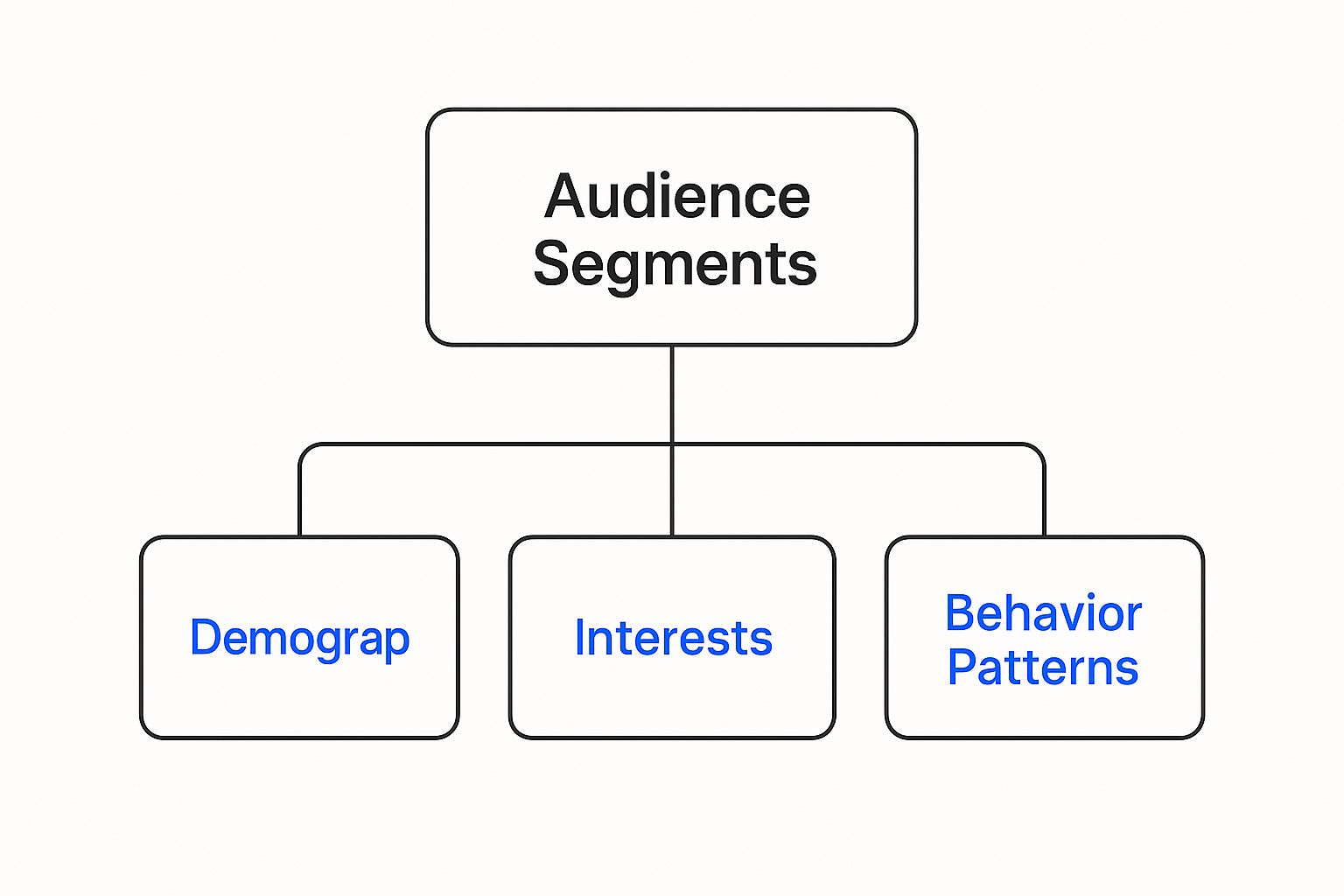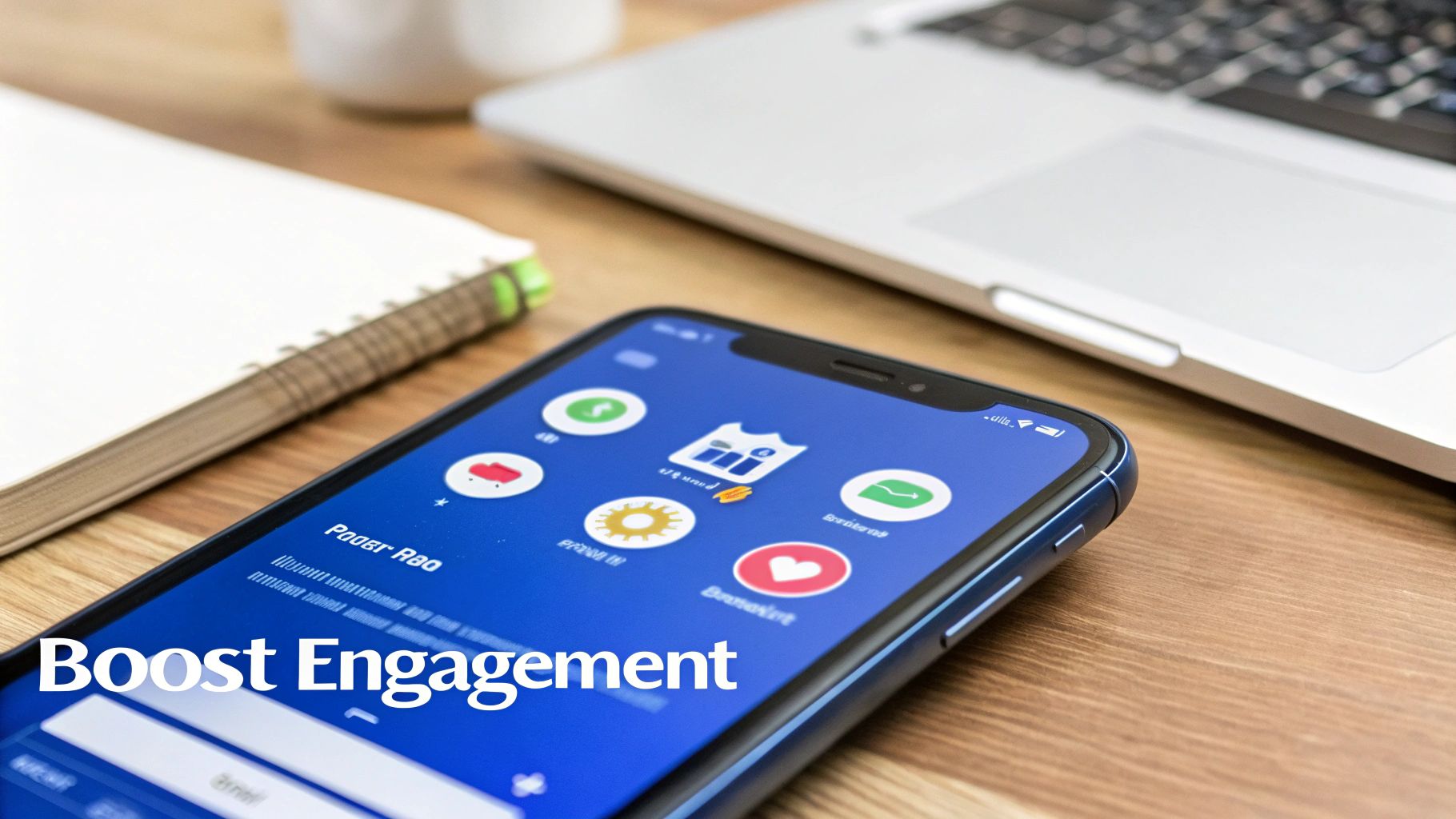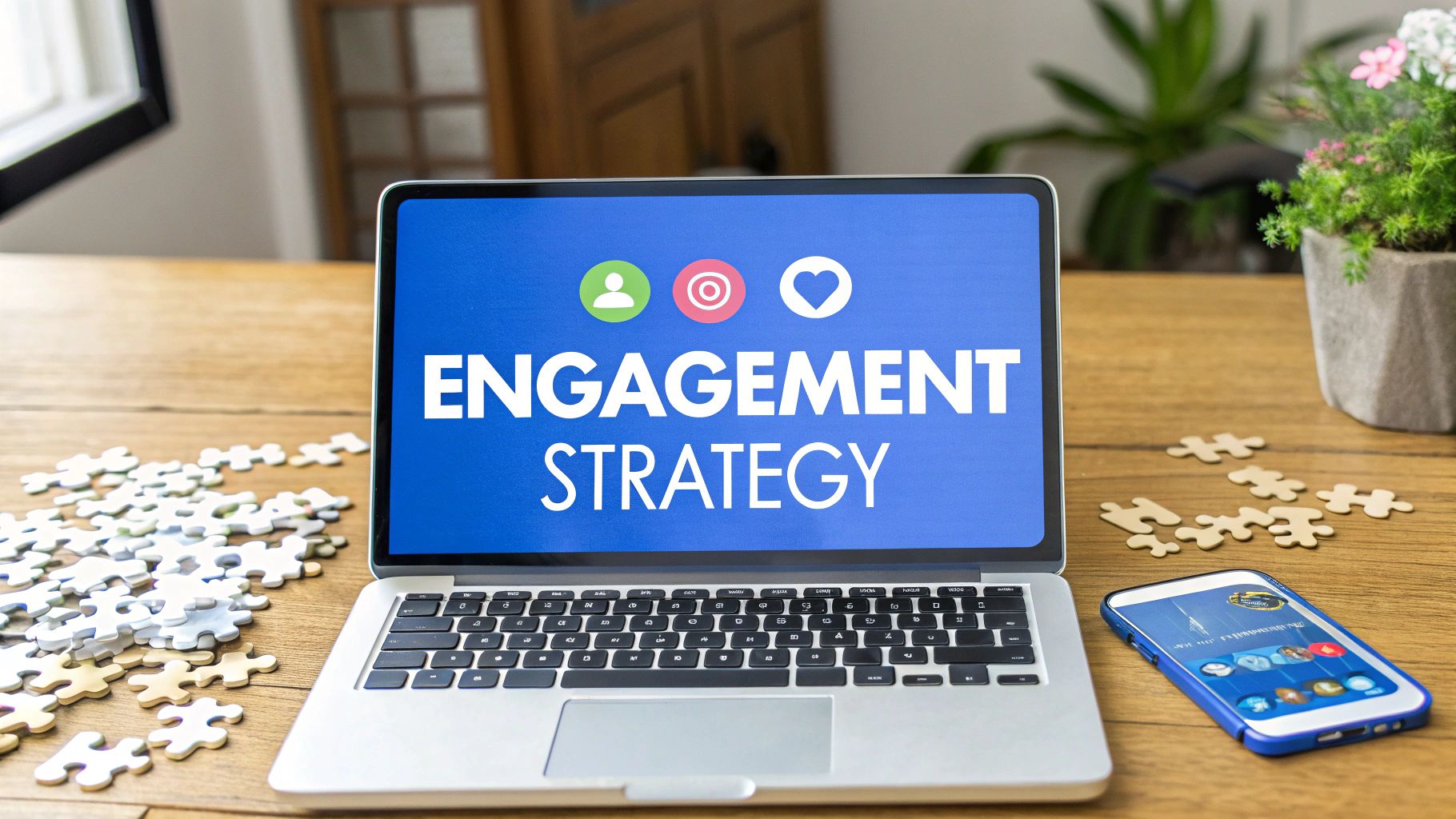Let's be real: a social media engagement strategy isn't about just throwing content at the wall and hoping something sticks. It’s a deliberate plan to build actual, two-way conversations and genuine relationships with your audience.
The goal is to stop being a broadcaster and start being a community builder. When you get this right, you transform passive followers into active, passionate advocates for your brand.
What Is a Social Media Engagement Strategy
Think of your social media presence less like a billboard and more like hosting a great dinner party. Your job isn't just to get people to show up. It's to make them feel welcome, spark conversations they actually enjoy, and create an experience that makes them want to come back.
This is what an engagement strategy is all about—a thoughtful plan for interacting with your audience to hit specific goals. It’s about moving past random posts and comments.
To do this, you need to know who your audience is, what makes them tick, and where they hang out online. And it's more important than ever. With 5.42 billion social media users worldwide and the average person juggling nearly seven different platforms a month, the space is incredibly crowded. Cutting through that noise requires a real connection.
The Core Pillars of an Engagement Strategy
A solid strategy doesn't just happen. It's built on four fundamental pillars that work together, creating a powerful cycle of connection and growth. Each one is a critical piece of the puzzle for building an active community.
To see how these pillars support each other, let's look at their individual objectives.
Core Pillars of an Engagement Strategy
| Pillar | Objective |
|---|---|
| Listening | The starting point. This is all about monitoring what people are saying about your brand, industry, and related topics. |
| Analyzing | Once you've listened, you need to understand what you heard. This is where you find trends, gauge sentiment, and spot opportunities. |
| Creating | Fueled by insights, you can now create content that people actually want and need, providing real value. |
| Interacting | The action step. This involves responding to comments, joining conversations, and actively building relationships. |
Think of these pillars as a continuous loop. You listen, you analyze what you've heard, you create something relevant, and then you interact, which gives you more to listen to. It’s the engine that drives sustainable organic growth.
Understanding Your Audience Segments
You can't talk to everyone the same way and expect it to work. To interact effectively, you have to know who you're talking to. Breaking your audience into smaller, more defined segments is the key to personalizing your communication and making it feel relevant. You can start by learning some foundational tips to increase social media engagement to grasp the core principles.
The image below gives a great visual of how you can start to group your audience.

As you can see, this goes way beyond just age and location. It digs into their interests and online habits to create a much clearer, more complete picture of who you're trying to connect with.
Why Platform-Specific Engagement Matters

Think of yourself as a stand-up comedian for a moment. Would you tell the same set of jokes at a buttoned-up corporate conference that you’d use for a late-night comedy club? Of course not. The room, the vibe, the expectations—they're all completely different.
Applying a one-size-fits-all social media engagement strategy is the digital version of telling the wrong joke to the wrong crowd. It’s a surefire way to get crickets.
Every social media platform has its own unique culture, unwritten rules, and user behavior. What gets you a standing ovation on one network will fall completely flat—or even come off as annoying—on another. A smart strategy doesn't just acknowledge this; it thrives on it.
A "spray and pray" approach, where you blast the exact same post everywhere, isn't just lazy; it’s a massive missed opportunity. To truly connect, you have to tweak your brand's voice, your content's style, and how you interact on each platform to feel like you actually belong there.
"Being everywhere with the motive to reach a broader audience will do more harm than good. You’ll not only reach the wrong audiences but end up wasting resources, which could have very easily been utilized more effectively elsewhere."
It all comes down to meeting your audience where they are—not just which app they're scrolling, but how they talk and what they want to see.
Decoding Each Platform's "Language"
Treat each social network like a different country. To connect with the locals, you have to learn to speak their language and respect their customs. Your whole social media engagement strategy hinges on becoming fluent.
- TikTok & Instagram Reels: This is the land of short-form, high-energy video. People are here for trends, quick laughs, and raw authenticity. A long, text-heavy dissertation would be scrolled past in a heartbeat.
- LinkedIn: Welcome to the professional world. Here, the currency is thought leadership, industry insights, and career-focused conversations. The hilarious meme that killed it on X will likely undermine your credibility here.
- Pinterest: This is a visual discovery engine. Users are actively planning, dreaming, and looking for inspiration. Your ticket to engagement is through high-quality images, beautiful infographics, and helpful tutorials.
Ignoring these differences is one of the most common reasons creators hit a wall with engagement. You have to match your content to the native culture of each platform to get real traction.
The Unique Case of Facebook
Even platforms that seem alike on the surface have crucial differences. Take Facebook. It might feel like old news to some, but it remains a powerhouse for a well-rounded social media engagement strategy.
As of 2025, Facebook is home to around 3.065 billion monthly active users, with the 25-34 age group still representing the largest slice at 31.1%. More than that, it has become a major hub for customer service, with Millennials, Gen X, and even Baby Boomers turning to it for support. It's also a beast in social commerce—a staggering 39% of users have bought something directly through the platform.
What does this tell us? A Facebook strategy needs to be a careful blend of community building, customer care, and direct sales. That's a completely different game plan than what you'd use for a trend-driven platform like TikTok.
How to Tailor Your Strategy
Adapting your strategy doesn't mean creating a new brand personality for every app. It's more about adjusting your delivery to fit the room.
- Tweak Your Brand Voice: Your core identity stays the same, but your tone shifts. Be polished and insightful on LinkedIn, then switch to being more casual and witty on X.
- Optimize Content Formats: Don't just copy-paste. Repurpose your core ideas into formats native to each platform. That blog post can become an Instagram carousel, an X thread, a short-form video for TikTok, and a deep-dive article for LinkedIn.
- Vary Your Interaction Style: On Instagram, "engagement" might be all about replying to DMs and story mentions. On X, it could mean jumping into trending topics or using a tool like Reply Guy to find conversations with serious momentum.
When you tailor your efforts like this, you send a clear message to your audience: you get them, you respect their time, and you belong in their feed. For a deeper dive into mastering these nuances, our guide on social media marketing best practices is a great next step. This platform-specific mindset is what turns generic posting into a real engine for organic growth.
Building Your Engagement Framework
Alright, let's move from theory to action. To get real results, you need a solid framework. Think of it as the blueprint for a house—without one, you're just nailing boards together and hoping the whole thing doesn't collapse. A good framework makes sure every single action you take is deliberate, repeatable, and aimed at hitting your goals.
This is what separates the creators who grow month after month from those stuck wondering what to do next. It’s how you turn random comments and likes into a powerful social media engagement strategy.
H3: Define Clear, Measurable Objectives
Before you even think about writing a post or a reply, you have to know what you’re trying to accomplish. And "more engagement" isn't a goal; it's a wish. You need specific, measurable targets that actually guide your work and tell you if you're winning.
What does success actually look like for you? Your objectives should connect directly to real outcomes. So, instead of just wanting more followers, let's get specific with metrics that move the needle.
- Boost Comment Rate: Aim to increase your average comments per post by 20% over the next quarter. This is a direct sign that your content is actually starting conversations.
- Improve Audience Sentiment: Use social listening to keep an eye on brand mentions and aim for a 15% increase in positive sentiment. This shows you're building a healthier, happier community.
- Increase Click-Through Rate (CTR): Set a goal to improve the CTR on your bio link by 10%. This proves your audience is motivated enough to take the next step.
Having clear targets like these gives you direction. It turns vague ideas into something you can actually measure and achieve.
H3: Develop Detailed Audience Personas
You can't connect with an audience you don't truly understand. This is where building detailed audience personas comes in. It’s like creating a character sheet for your ideal follower, going way beyond simple demographics. You need to dig into what makes them tick—their motivations, their frustrations, and how they act online.
An audience persona is a semi-fictional representation of your ideal customer based on market research and real data about your existing customers. It helps you focus your time on qualified prospects, guide product development, and align all work across your organization.
To start building these personas, ask yourself some key questions:
- In your niche, what are their biggest challenges?
- What kind of content do they actually find valuable? Is it tutorials, humor, or deep industry news?
- Which social media platforms do they live on, and how do they use them?
- What's their "voice"? Are they super professional, casual and witty, or more academic?
When you can answer these, you can step into their shoes. That’s when you can start crafting content and interactions that feel personal, relevant, and like they were made just for them.
H3: Establish a Consistent Brand Voice
Your brand voice is the personality that shines through in everything you publish. It’s not just what you say, but how you say it. When your voice is consistent, people start to trust you. Your brand feels familiar and reliable, like an old friend.
So, who are you? Are you the witty sidekick, the wise mentor, the high-energy coach, or the sophisticated expert? You need to define this. This voice should be the guide for every reply, every post, and every DM you send. If you want to see how the pros do it, exploring different social media engagement strategies is a great way to see this in action with real-world examples.
H3: Create Strategic Content Pillars
Finally, your content itself needs a plan. This is where content pillars come in handy. Think of them as 3-5 core themes or topics you’ll talk about over and over again. They become the foundation of your content calendar, making sure every single post aligns with what your audience cares about and what you want to achieve.
For instance, a fitness coach’s pillars might look like this:
- Workout Tutorials: Actionable, easy-to-follow exercise guides.
- Nutrition Tips: Simple, practical advice for healthy eating.
- Mindset & Motivation: Inspirational content to keep followers going.
- Client Success Stories: Real-world proof that your methods work.
Having pillars like these gives you a repeatable system. You’ll never have to wake up and wonder, "What on earth do I post today?" It keeps your feed focused, purposeful, and built for engagement that lasts.
Mastering the Art of Authentic Interaction

Okay, you've got the framework down. Now comes the fun part—the daily actions that make your social media engagement strategy actually work. This is where the magic really happens, turning your plan from a static document into a living, breathing part of your brand.
The goal here is simple: stop being a content broadcaster and start being an active, valuable member of your community.
Authentic interaction is all about starting and sustaining real conversations. It's so much more than dropping a "thanks!" or a fire emoji. It’s about showing your audience that you're not just scanning their comments, you're genuinely listening to what they have to say.
This mindset shift is everything. Instead of just pushing content out, you start pulling people in. You create a space where they feel seen and appreciated, building a kind of loyalty that will outlast any fleeting trend.
Go Beyond Basic Replies
Let's be honest, simple replies are the bare minimum. The accounts that are actually growing are the ones that use advanced engagement tactics to get people talking. The secret is to create opportunities for interaction instead of just waiting for them to happen. This is how you turn passive scrollers into active fans.
So, how do you do that? You need a few solid techniques in your back pocket that invite responses and make it easy for your audience to join in.
Here are a few powerful ways to get started:
- Ask Open-Ended Questions: Ditch the simple yes/no questions. Instead of "Do you like our new feature?" try asking, "What's one creative way you would use our new feature?" See the difference? One ends the conversation, the other starts it.
- Run Interactive Polls and Quizzes: These are fantastic, low-effort ways for your audience to engage. Use them to gather opinions, test what they know, or just have some fun. A single poll can spark hundreds of interactions and give you a goldmine of audience insights.
- Host Live Q&A Sessions: There's nothing like live video to create a sense of urgency and direct access. Announce an "Ask Me Anything" (AMA) session to tackle questions in real-time. It's a powerful way to build a personal connection with your followers.
When you use tactics like these, you change the entire dynamic. You're no longer just talking at your audience; you're building something with them.
Personalize Your Responses
In a world full of automated bots and copy-paste replies, personalization is your superpower. When someone takes the time to leave a thoughtful comment on your post, a personalized response shows you actually value their effort. It makes them feel like an individual, not just another number boosting your metrics.
Don't just reply; connect. Use their username, reference a specific point they made, or even take a quick glance at their profile to add a relevant, personal touch.
A personalized response can turn a one-time commenter into a long-term brand advocate. It’s a small investment of time that pays huge dividends in community trust and loyalty.
Let's say a user comments, "Great post!" A generic reply is, "Thanks!" A personalized reply? That sounds more like, "@JohnDoe Thanks, John! Glad you found it helpful. I saw from your profile you're into [related topic]—did you find the section on [specific point] most useful?" That level of detail shows you actually care.
Embrace Proactive Engagement
Fantastic engagement isn't just about what happens on your own posts. A truly effective social media engagement strategy means getting out there and being proactive. It involves stepping outside your own profile and becoming a valuable voice in conversations happening all across your niche.
This is the whole idea behind tools like Reply Guy, which is designed to help creators find high-momentum conversations on X. By jumping into relevant, trending discussions, you can:
- Build Authority: When you share valuable insights in other people's threads, you start to be seen as an expert.
- Gain Visibility: Your thoughtful replies get your profile in front of a brand new, highly relevant audience.
- Attract Followers: People notice when you add value. They're far more likely to check out your profile and hit that "follow" button.
Think of it like networking at a conference. You wouldn't just stand silently at your own booth, would you? You'd walk the floor, join conversations, and build relationships. The same logic applies online. To see how well it's working, you can even track key metrics after these interactions. Monitoring your growth is simple with a good Twitter engagement rate calculator, which helps put real numbers to your efforts.
By mastering these interaction techniques, you make the final shift from being a passive content creator to an active community leader.
Using Tech and AI for Smarter Engagement
To really nail a modern social media engagement strategy, you have to work smarter, not just harder. While genuine connection is always a human-to-human effort, the right tech and AI can be incredible allies. They can help you scale your outreach, amplify your impact, and give you back your most precious resource—time.
Think of technology as your behind-the-scenes partner. It’s not here to replace your personality or creative spark. Instead, it does the heavy lifting, like sifting through the endless online noise to find those golden opportunities for you to connect. This frees you up to do what you do best: build real relationships.
Harnessing Social Listening for Real-Time Opportunities
One of the most powerful tools you can have is social listening. This isn't just about keeping an eye on your own @mentions. True social listening is like having super-powered hearing that lets you tune into important conversations happening all across your niche.
By tracking specific keywords, hashtags, and even what people are saying about your competitors, you can uncover live discussions where your expertise would be genuinely valuable. It's the difference between waiting for people to show up at your party and finding the best parties already happening and jumping right in. This proactive approach is what separates a static strategy from a dynamic one.
Good social listening also doubles as an early warning system for your brand. Catching feedback and mentions early on lets you steer conversations before they blow up, which is a cornerstone of solid social media reputation management.
The Role of AI in Creative and Strategic Engagement
Artificial intelligence isn't some far-off concept anymore; it's a practical tool that can seriously sharpen your engagement game. AI’s real power is its ability to chew through massive amounts of data in seconds, spotting patterns and trends a human could never catch on their own.
For creators, this opens up a ton of new avenues:
- Sparking Content Ideas: AI can analyze the top-performing content in your field and suggest fresh topics, angles, or formats that your audience is likely to love.
- Analyzing Audience Sentiment: These tools can scan comments and mentions to paint a clear picture of how your community is feeling, helping you fine-tune your tone and approach.
- Drafting Initial Content: Stuck with writer's block? AI can whip up a first draft for a post or caption. From there, you just need to polish it and add your unique voice.
People around the world spend a staggering 14 billion hours on social media every day. It's a massive arena for engagement, and businesses are using technology to get an edge. In fact, a remarkable 90% of businesses using generative AI report saving significant time on content creation, and 73% see a real bump in engagement from their AI-assisted content.
This data highlights a key takeaway: AI doesn't replace the human element. It enhances it by giving your creativity a data-backed direction.
Putting AI into Practice
You don't need a huge budget or a data science degree to start using AI. There are plenty of accessible tools out there that can slide right into your daily workflow, saving you time and boosting the quality of your posts.
For a simple, practical start, something like a free AI Instagram caption generator can be a huge help. By giving you a solid starting point, these tools free you up to focus on the more strategic, conversational side of your social media engagement strategy. That means every post goes out polished and primed to start a conversation.
How to Measure Your Engagement Success

It’s one thing to feel like your social media engagement strategy is clicking, but it’s another thing entirely to prove it. Without solid numbers to back you up, you're essentially just flying blind and hoping for the best. Measuring your success is the only way to make smart, data-driven decisions and show that your efforts are actually moving the needle.
This is where we go beyond the flashy, feel-good numbers like your total follower count. Sure, a big audience looks impressive, but it doesn't mean anyone is actually listening. True measurement means digging into the metrics that reveal a healthy, thriving community.
Moving Beyond Vanity Metrics
The first real step toward meaningful measurement is shifting your focus from numbers that simply look good on the surface to numbers that tell a story. Think about it: an account with 100,000 followers and only 10 likes per post is like an empty stadium. The real win is a smaller, dedicated audience that hangs on your every word.
To truly understand your impact, it's essential to master how to measure social media engagement effectively. This means focusing on actions that show genuine interest and connection, not just passive viewership.
Key Engagement Metrics to Track
So, what should you be looking at? It's easy to get lost in a sea of data, but a few key metrics will give you a clear picture of your strategy's performance. These metrics help you understand the quality of your interactions, not just the quantity.
| Metric | What It Measures | Why It Matters |
|---|---|---|
| Engagement Rate | The percentage of your audience that actively interacts with your content (likes, comments, shares, saves). | This is your North Star. It's the clearest sign that your content is resonating and people are actually paying attention. |
| Comment Sentiment | The overall tone (positive, negative, or neutral) of the comments you receive. | High engagement is great, but positive sentiment confirms you're building a supportive community that genuinely connects with your brand. |
| Audience Growth Rate | How quickly you're gaining new followers, usually measured as a percentage over a specific period. | This shows momentum. A steady upward trend indicates your strategy is consistently attracting the right people to your profile. |
By tracking these numbers, you get a much sharper, more accurate view of your community’s health and the true impact of your work.
Using Native Analytics to Your Advantage
The good news is you don’t need a bunch of expensive, complicated tools to get started. Every major social platform comes with its own free analytics dashboard, and they are gold mines of information. Tools like X Analytics, Instagram Insights, and Facebook Insights should become your best friends.
These dashboards show you which posts are hitting the mark, what time of day your audience is most active, and a detailed breakdown of your follower demographics. Get into the habit of checking these dashboards weekly. Look for patterns, pinpoint your best-performing content, and let those insights shape what you create next.
For a deeper dive into these platform-specific tools, our guide on https://www.getreplyguy.com/blog/how-to-measure-social-media-engagement offers a more detailed walkthrough.
Even creating a simple spreadsheet to track these key numbers over time can be a game-changer. It turns measurement from a chore into your most powerful tool for growth, ensuring your strategy delivers real, tangible results.
Your Top Social Engagement Questions, Answered
Even with the best plan in hand, you're bound to run into a few tricky situations when you're in the trenches. Turning a strategy into real-world growth means knowing how to handle these common bumps in the road. Let's tackle some of the most frequent questions I hear from creators.
How Much Time Should I Really Spend on Engagement?
This is the big one, right? The classic "how long is a piece of string?" question. But here's the deal: it’s not about how many hours you clock, it's about the quality of those minutes. Forget aiming for some vague, arbitrary number.
The secret is consistency.
Try setting aside 20-30 minutes for focused engagement, maybe once in the morning and once in the afternoon. During these blocks, you have one job: engage. That means thoughtful replies and hunting for new conversations to join. It's a much smarter approach than being "always on" but constantly distracted.
Consistency trumps intensity. Two focused 20-minute sessions of genuine interaction will do more for your growth than three hours of mindless scrolling. Your audience will remember a quality response far more than an instant one.
What Do I Do About Negative Comments?
Sooner or later, it happens to everyone. Negative feedback is just part of the game, and how you react says everything about you and your brand. Ignoring it lets the issue simmer, and just deleting comments almost always blows up in your face. The best move is to stay calm and be strategic.
Here’s a simple playbook:
- Acknowledge in Public, Fix in Private: A quick, professional public reply is all you need. Something like, "So sorry you ran into this issue. I just sent you a DM to get the details and make it right." This shows everyone else you’re on top of it.
- Don't Feed the Trolls: You have to learn the difference between real criticism and someone just trying to get a rise out of you. Address the real concerns, but feel free to ignore or block anyone acting in bad faith. Arguing with a troll just gives them a bigger platform.
- Look for the Lesson: Honestly, even a poorly worded complaint can have a nugget of truth inside. Think of it as free market research. It can help you spot weaknesses in your content or product that you might have missed.
Do I Have to Post Every Single Day?
The pressure to be everywhere all the time is intense, I get it. But quality will always, always beat quantity. Pushing out weak content just to check a box on your calendar can actually tank your engagement. The algorithms notice when posts fall flat, and it can hurt your reach.
Instead, find a rhythm you can actually stick to without burning out or phoning it in. For most creators, posting 3-5 times a week on their main platform is the sweet spot. You'll stay on your audience's radar without sacrificing the quality that made them follow you in the first place.
Ready to stop guessing and start growing? Reply Guy is the go-to tool for X creators who want to find red-hot conversations and turn impressions into loyal followers. Pinpoint viral tweets, jump in at the perfect moment, and watch your audience grow without the grind. Get lifetime access to Reply Guy with a simple one-time purchase.
